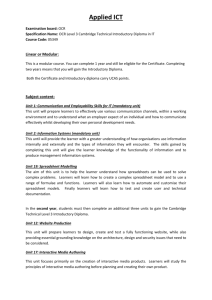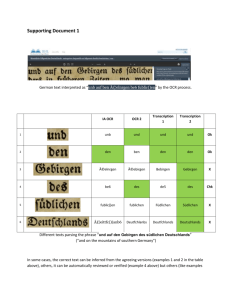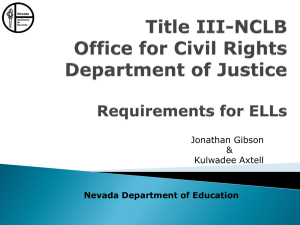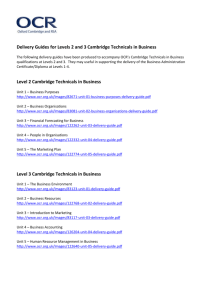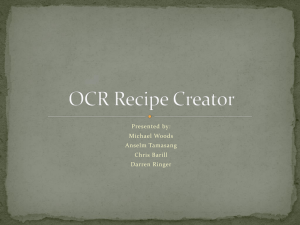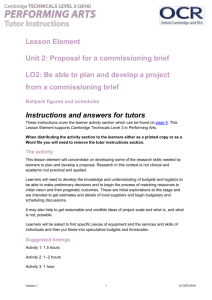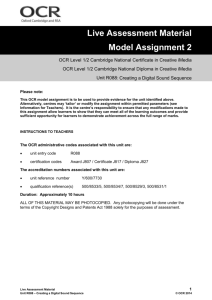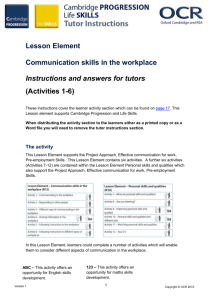Prepare to work in the performing arts sector
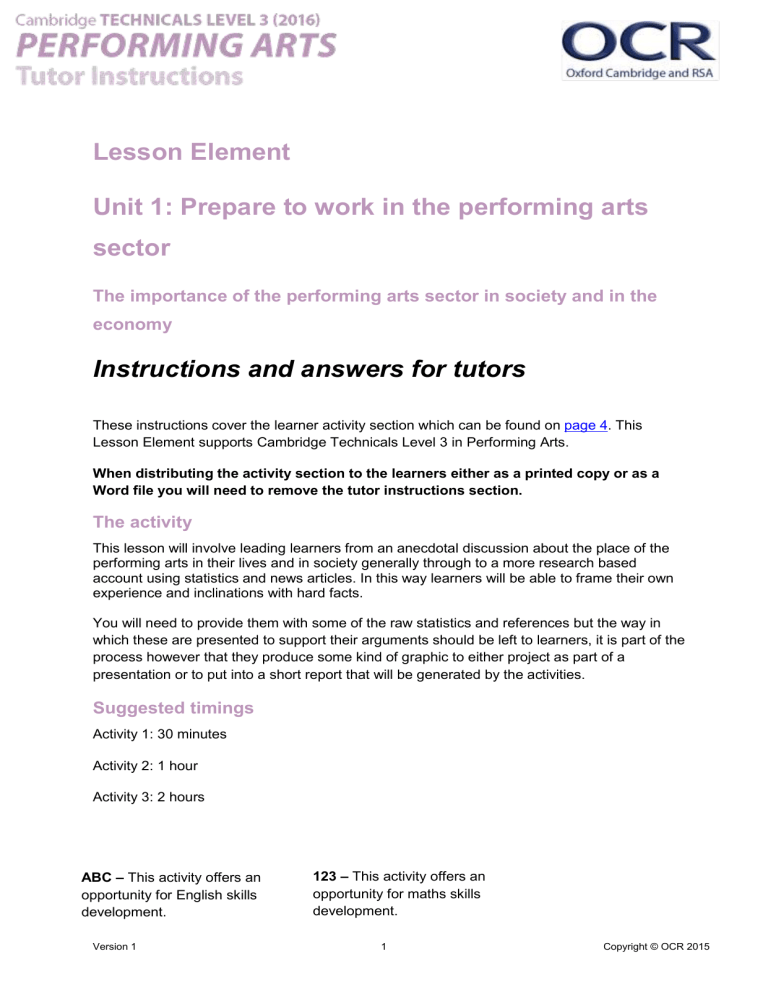
Lesson Element
Unit 1: Prepare to work in the performing arts sector
The importance of the performing arts sector in society and in the economy
Instructions and answers for tutors
These instructions cover the learner activity section which can be found on page 4 . This
Lesson Element supports Cambridge Technicals Level 3 in Performing Arts.
When distributing the activity section to the learners either as a printed copy or as a
Word file you will need to remove the tutor instructions section.
The activity
This lesson will involve leading learners from an anecdotal discussion about the place of the performing arts in their lives and in society generally through to a more research based account using statistics and news articles. In this way learners will be able to frame their own experience and inclinations with hard facts.
You will need to provide them with some of the raw statistics and references but the way in which these are presented to support their arguments should be left to learners, it is part of the process however that they produce some kind of graphic to either project as part of a presentation or to put into a short report that will be generated by the activities.
Suggested timings
Activity 1: 30 minutes
Activity 2: 1 hour
Activity 3: 2 hours
ABC – This activity offers an opportunity for English skills development.
Version 1
123 – This activity offers an opportunity for maths skills development.
1 Copyright © OCR 2015
Activity 1
Ask learners to get into small groups to discuss the place of the arts in their lives. You could provide a set of questions or statements that could be biased towards specific art-forms but a general discussion that engages memories and feelings will give an underpinning to later more ‘scientific’ accounts.
These initial questions could focus on memories, stories and anecdotes.
Activity 2
Depending on how you want to approach this activity you could ask learners to prepare statistical facts and figures in advance or you could provide projections of ones already collated by yourself. The classroom activity is the same – they should begin to understand the implications of these statistics and prepare presentations that persuade sceptics about the importance of the sector.
Learners could access websites that give statistics for the Creative Industry and collate relevant tables and figures. Tutors could sub-divide the group so that very specific statistics are being sourced, i.e. one group will look for industry as a whole, while another will look for performing arts only. https://www.gov.uk/government/statistics/creative-industries-economic-estimates-january-
2015 is a good starting point. This is provided by the Department for Culture, Media and
Sport. It is a big document so needs the suggested small group or individual focus to look for specific tables.
Learners could produce a range of rough charts and tables from a given statistical base. This will involve converting them into other graphic formats to be used on flip charts or power-point presentations.
At this stage they just need to decide on a way that they will be presented.
Tutors could direct learners to sites such as https://www.mathsisfun.com/data/pie-charts.html
for ideas.
Version 1 2 Copyright © OCR 2015
Activity 3
Once learners have engaged with the importance and significance of the performing arts sector and also begun to understand the economic benefits, you could ask them to prepare a presentation or a report that illustrates these impacts.
This could start with a personal anecdote or story and then begin to give hard evidence and statistical information.
A good example of a written account of this impact can be found at https://www.thestage.co.uk/news/2013/arts-worth-5-9bn-to-uk-economy-report/ but learners should also be asked to make their presentation or report more engaging by adding graphs, charts and photographs.
We’d like to know your view on the resources we produce. By clicking on ‘
Like
’ or ‘
Dislike
’ you can help us to ensure that our resources work for you. When the email template pops up please add additional comments if you wish and then just click ‘Send’. Thank you.
If you do not currently offer this OCR qualification but would like to do so, please complete the Expression of Interest
Form which can be found here: www.ocr.org.uk/expression-of-interest
OCR Resources : the small print
OCR’s resources are provided to support the teaching of OCR specifications, but in no way constitute an endorsed teaching method that is required by the Board, and the decision to use them lies with the individual teacher. Whilst every effort is made to ensure the accuracy of the content, OCR cannot be held responsible for any errors or omissions within these resources.
© OCR 2015 - This resource may be freely copied and distributed, as long as the OCR logo and this message remain intact and OCR is acknowledged as the originator of this work.
OCR acknowledges the use of the following content: Maths and English icons: Air0ne/Shutterstock.com
Please get in touch if you want to discuss the accessibility of resources we offer to support delivery of our qualifications: resources.feedback@ocr.org.uk
Version 1 3 Copyright © OCR 2015
Lesson Element
Unit 1: Prepare to work in the performing arts sector
Learner Activity
The importance of the performing arts sector in society and in the economy
In this lesson we are going to think about what the arts generally and the performing arts in particular provide for all of us in society. This is going to be anecdotal ; what we personally think and feel about the arts and what they have done for us individually and it is also going to be factual and statistical; what facts and figures tell us about how important the arts are economically and for the overall well-being of society.
You will have discussions and make notes on these and you will also prepare presentations and reports that present a case for the performing arts sector and its importance.
Activity 1
Working with a partner or a small group, have a discussion about what the arts have meant to you in your lives so far. This can be based on early memories of live performances, like pantos or on TV programmes that stick in your memory because of the emotional effect they had on you at the time or there might be a particular song that represents a special treat or moment of sadness. You don’t have to limit it to performing arts, you might have looked at a painting that had a lasting impact on you.
As part of the activity one of you should make notes about the range and types of impact that these events had on your lives and what you think or feel now. You could use the following questions as a starting point:
Can you remember the first live performance you saw? Describe this and how it made you feel.
What was your favourite childr en’s programme, who was in this?
Have you been to a pantomime/art gallery/concert/gig – why do you enjoy going to these events?
What was passed on to you by parents/carers in terms of artistic or musical preferences?
What would you want to pass on to your children?
Copyright © OCR 2015 Version 1 4
Activity 2
You will need to find a set of facts and figures that give information about how the performing arts sector contributes to the British economy. You will be working in groups so you will only need to find one set of statistics individually – or one fact that is supported by a news article that contains some figures - and then you will pool these as a group and make decisions about how these will be converted into graphs and visual presentations.
One place to start would be government statistics found at https://www.gov.uk/government/statistics/creative-industries-economic-estimates-january-
2015
Just talking about these facts, figures and statistics will seem a bit dry and an audience or someone sceptical about the importance of the sector may stop listening. So in your own engagement with these facts you could begin to work out how they could be presented to give them more impact.
Activity 3
Now that you have begun to understand the impact of the performing arts sector on a personal and on an economic level you should prepare a presentation that illustrates this impact to a sceptical audience. This audience can be specified by you and your group but they should not work in the arts
Presentations should be no longer than 10 minutes long and should include some graphic material – this should be in the form of a chart or graph and could also include photographs or other illustrations. This could be in the form of a short written report but you will still need to present this report, perhaps in the form of a briefing or press conference.
Version 1 5 Copyright © OCR 2015


